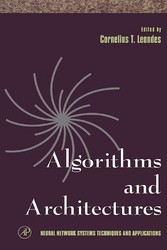Suchen und Finden
Cover
1
Contents
6
Contributors
16
Preface
20
Chapter 1. Statistical Theories of Learning in Radial Basis Function Networks
26
I. Introduction
26
II. Learning in Radial Basis Function Networks
29
III. Theoretical Evaluations of Network Performance
46
IV. Fully Adaptive Training„An Exact Analysis
65
V. Summary
79
Appendix
80
References
82
Chapter 2. Synthesis of Three-Layer Threshold Networks
86
I. Introduction
87
II. Preliminaries
88
III. Finding the Hidden Layer
89
IV. Learning an Output Layer
98
V. Examples
102
VI. Discussion
109
VII. Conclusion
110
References
111
Chapter 3. Weight Initialization Techniques
112
I. Introduction
112
II. Feedforward Neural Network Models
114
III. Stepwise Regression for Weight Initialization
115
IV. Initialization of Multilayer Perceptron Networks
117
V. Initial Training for Radial Basis Function Networks
123
VI. Weight Initialization in Speech Recognition Application
128
VII. Conclusion
141
Appendix I: Chessboard 4 X 4
141
Appendix II: Two Spirals
142
Appendix III: GaAs MESFET
142
Appendix IV: Credit Card
142
References
143
Chapter 4. Fast Computation in Hamming and Hopfield Networks
148
I. General Introduction
148
II. Threshold Hamming Networks
149
III. Two-Iteration Optimal Signaling in Hopfield Networks
160
IV. Concluding Remarks
177
References
178
Chapter 5. Multilevel Neurons
180
I. Introduction
180
II. Neural System Analysis
182
III. Neural System Synthesis for Associative Memories
192
IV. Simulations
196
V. Conclusions and Discussions
198
Appendix
198
References
203
Chapter 6. Probabilistic Design
206
I. Introduction
206
II. Unified Framework of Neural Networks
207
III. Probabilistic Design of Layered Neural Networks
214
IV. Probability Competition Neural Networks
222
V. Statistical Techniques for Neural Network Design
243
VI. Conclusion
253
References
253
Chapter 7. Short Time Memory Problems
256
I. Introduction
256
II. Background
257
III. Measuring Neural Responses
258
IV. Hysteresis Model
259
V. Perfect Memory
262
VI. Temporal Precedence Differentiation
264
VII. Study in Spatiotemporal Pattern Recognition
266
VIII. Conclusion
270
Appendix
271
References
285
Chapter 8. Reliability Issue and Quantization Effects in Optical and Electronic Network Implementations of Hebbian-Type Associative Memories
286
I. Introduction
286
II. Hebbian-Type Associative Memories
289
III. Network Analysis Using a Signal-to-Noise Ratio Concept
291
IV. Reliability Effects in Network Implementations
293
V. Comparison of Linear and Quadratic Networks
303
VI. Quantization of Synaptic Interconnections
306
VII. Conclusions
313
References
314
Chapter 9. Finite Constraint Satisfaction
318
I. Constrained Heuristic Search and Neural Networks for Finite Constraint Satisfaction Problems
318
II. Linear Programming and Neural Networks
348
III. Neural Networks and Genetic Algorithms
356
IV. Related Work, Limitations, Further Work, and Conclusions
366
Appendix I. Formal Description of the Shared Resource Allocation Algorithm
367
Appendix II. Formal Description of the Conjunctive Normal Form Satisfiability Algorithm
371
Appendix III. A 3-CNF-SAT Example
373
Appendix IV. Outline of Proof for the Linear Programming Algorithm
375
References
384
Chapter 10. Parallel, Self-Organizing, Hierarchical Neural Network Systems
388
I. Introduction
389
II. Nonlinear Transformations of Input Vectors
391
III. Training, Testing, and Error-Detection Bounds
392
IV. Interpretation of the Error-Detection Bounds
396
V. Comparison between the Parallel, Self-Organizing, Hierarchical Neural Network, the Backpropagation Network, and the Maximum Likelihood Method
398
VI. PNS Modules
404
VII. Parallel Consensual Neural Networks
406
VIII. Parallel, Self-Organizing, Hierarchical Neural Networks with Competitive Learning and Safe Rejection Schemes
410
IX. Parallel, Self-Organizing, Hierarchical Neural Networks with Continuous Inputs and Outputs
417
X. Recent Applications
420
XI. Conclusions
424
References
424
Chapter 11. Dynamics of Networks of Biological Neurons: Simulation and Experimental Tools
426
I. Introduction
427
II. Modeling Tools
428
III. Arrays of Planar Microtransducers for Electrical Activity Recording of Cultured Neuronal Populations
443
VI. Concluding Remarks
446
References
447
Chapter 12. Estimating the Dimensions of Manifolds Using Delaunay Diagrams
450
I. Delaunay Diagrams of Manifolds
450
II. Estimating the Dimensions of Manifolds
460
III. Conclusions
480
References
481
Index
482
Alle Preise verstehen sich inklusive der gesetzlichen MwSt.













